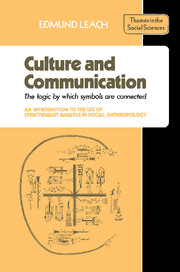 Culture and Communication
Culture and Communication Book contents
- Frontmatter
- Contents
- Culture and communication: the logic by which symbols are connected
- Introduction
- 1 Empiricists and rationalists: economic transactions and acts of communication
- 2 Problems of terminology
- 3 Objects, sense-images, concepts
- 4 Signals and indices
- 5 Transformations
- 6 Theories of magic and sorcery
- 7 The symbolic ordering of a man-made world: boundaries of social space and time
- 8 The material representation of abstract ideas: ritual condensation
- 9 Orchestral performance as a metaphor for ritual sequence
- 10 The physiological basis of sign/symbol sets
- 11 Mapping: time and space as reciprocal representations
- 12 Rank order and orientation
- 13 Examples of binary coding
- 14 Mating prescriptions and proscriptions
- 15 Logic and mytho-logic
- 16 Basic cosmology
- 17 Rites of transition (rites de passage)
- 18 The logic of sacrifice
- 19 Conclusion
- Bibliography
- Index
13 - Examples of binary coding
Published online by Cambridge University Press: 05 June 2012
- Frontmatter
- Contents
- Culture and communication: the logic by which symbols are connected
- Introduction
- 1 Empiricists and rationalists: economic transactions and acts of communication
- 2 Problems of terminology
- 3 Objects, sense-images, concepts
- 4 Signals and indices
- 5 Transformations
- 6 Theories of magic and sorcery
- 7 The symbolic ordering of a man-made world: boundaries of social space and time
- 8 The material representation of abstract ideas: ritual condensation
- 9 Orchestral performance as a metaphor for ritual sequence
- 10 The physiological basis of sign/symbol sets
- 11 Mapping: time and space as reciprocal representations
- 12 Rank order and orientation
- 13 Examples of binary coding
- 14 Mating prescriptions and proscriptions
- 15 Logic and mytho-logic
- 16 Basic cosmology
- 17 Rites of transition (rites de passage)
- 18 The logic of sacrifice
- 19 Conclusion
- Bibliography
- Index
Summary
In Section 2 I assumed that ‘all the various non-verbal dimensions of culture … are organised in patterned sets so as to incorporate coded information…’ (p. 10) and I have repeatedly implied a close analogy between, for example, the cultural conventions governing the wearing of clothes and the grammatical and phonological rules governing the pattern of speech utterances. In particular I have reiterated the leitmotif which I spelled out at the end of Section 10: ‘a sign or symbol only acquires meaning when it is discriminated from some other contrary sign or symbol’ and ‘they do not have meaning as isolates but only as members of sets’.
I shall now consider some practical, though very cursory and superficial, examples of this formula in rather greater detail. But let me be clear; these examples are intended just as rough illustrations of what I have been talking about. Read again what I said about ethnographic evidence in my introduction. If you want to understand the real force of the argument you must dig up further more complicated examples for yourself.
(a) Costume
Taken out of context, items of clothing have no ‘meaning’; they can be stacked away in a drawer like the individual letters which a typographer uses to make up his typeface but, when put together in sets to form a uniform, they form distinctive markers of specified social roles in specified social contexts. Male and female, infant, child and adult, master and servant, bride and widow, soldier, policeman, high court judge, are all immediately recognisable by the clothing they wear.
- Type
- Chapter
- Information
- Culture and CommunicationThe Logic by which Symbols Are Connected. An Introduction to the Use of Structuralist Analysis in Social Anthropology, pp. 55 - 64Publisher: Cambridge University PressPrint publication year: 1976


